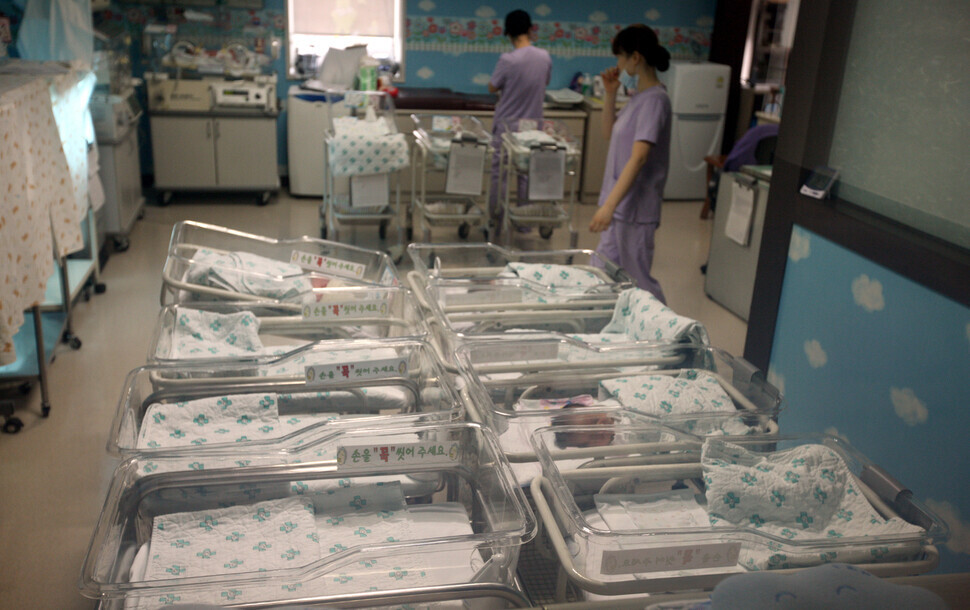hankyoreh
Links to other country sites 다른 나라 사이트 링크
Low birth rate to be biggest factor in crises Korea will face this decade

Working-age South Koreans (aged 15 to 64) represented 71% of the total population in 2022, which was higher than China (69%), the US (64.9%) and Japan (58.5%). But that fact is predicted to change significantly by 2040.
According to the UN’s global population projections, Korea’s working-age share of the population will fall to 56.8% by 2040, much lower than China (62.9%) or the US (61.5%). Japan is projected to be even lower than Korea, at 53.8%.
The demographic downturn is the most worrying of crisis factors over the upcoming decade, according to civilian participants in the first conference of subcommittee chairs of the Industrial Transformation Forum. The conference, held at the Korea Chamber of Commerce and Industry in downtown Seoul on Thursday, was chaired by Minister of Trade, Industry and Energy Lee Chang-yang.
Speakers observed that Korea has hitherto been able to sustain growth through the “demographic bonus” brought by a large working-age population and a small dependent population. But in the future, Koreans will have to worry about the “demographic onus” of a smaller workforce, which will put a drag on economic growth.
Along with the rapidly shrinking population, another matter of concern is the exodus of talented people from the country. According to a brain drain index developed in 2020 by the Swiss-based International Institute for Management Development, Korea had a score of 4 (on a scale of 0 to 10), ranking 43rd out of 64 major countries.
Korea was behind the US (6th), Germany (9th), Japan (27th) and even China (40th) on the scale. The lower the ranking, the worse the brain drain.
That ties into another problem: Korea has the lowest utilization of foreign experts in the Organisation for Economic Co-operation and Development. As of 2020, Korea’s foreign-born population share was just 2.4%, far below the 14.1% average across the OECD’s 37 member states.
Another major crisis factor that came up during the forum was the industrial hollowing out caused by a rapid increase in investment overseas.
Korean companies’ foreign direct investment has been rising by more than 10% every year (US$30.4 billion in 2015, US$44.9 billion in 2017, and US$75.9 billion in 2021), more than double foreign companies’ investment in Korea over the same period (US$16.8 billion, US$23 billion, and US$29.5 billion).
Furthermore, investment in the domestic manufacturing sector has hovered around 100 trillion won since 2017.
Other potential threats to the Korean economy are the chronic burden caused by the backward corporate environment (including adversarial labor relations), the lack of new growth engines, the bottomless pit of R&D, and the growing complexity of the global environment.
The conference was held following the launch of the Industrial Transformation Forum in October 2022. The forum consists of more than a hundred figures from business groups covering the areas of industry, academics and R&D.
This was the first plenary session bringing together government officials and civilian chairs of six subcommittees for investment, workforce, productivity, corporate environmental, global strategy, and new business.
By Kim Young-bae, senior staff writer
Please direct questions or comments to [english@hani.co.kr]

Editorial・opinion
![[Column] The state is back — but is it in business? [Column] The state is back — but is it in business?](https://flexible.img.hani.co.kr/flexible/normal/500/300/imgdb/original/2024/0506/8217149564092725.jpg) [Column] The state is back — but is it in business?
[Column] The state is back — but is it in business?![[Column] Life on our Trisolaris [Column] Life on our Trisolaris](https://flexible.img.hani.co.kr/flexible/normal/500/300/imgdb/original/2024/0505/4817148682278544.jpg) [Column] Life on our Trisolaris
[Column] Life on our Trisolaris- [Editorial] Penalties for airing allegations against Korea’s first lady endanger free press
- [Editorial] Yoon must halt procurement of SM-3 interceptor missiles
- [Guest essay] Maybe Korea’s rapid population decline is an opportunity, not a crisis
- [Column] Can Yoon steer diplomacy with Russia, China back on track?
- [Column] Season 2 of special prosecutor probe may be coming to Korea soon
- [Column] Park Geun-hye déjà vu in Yoon Suk-yeol
- [Editorial] New weight of N. Korea’s nuclear threats makes dialogue all the more urgent
- [Guest essay] The real reason Korea’s new right wants to dub Rhee a founding father
Most viewed articles
- 1[Column] Why Korea’s hard right is fated to lose
- 2Amid US-China clash, Korea must remember its failures in the 19th century, advises scholar
- 360% of young Koreans see no need to have kids after marriage
- 4[Column] The state is back — but is it in business?
- 5Presidential office warns of veto in response to opposition passing special counsel probe act
- 6OECD upgrades Korea’s growth forecast from 2.2% to 2.6%
- 7Hybe-Ador dispute shines light on pervasive issues behind K-pop’s tidy facade
- 8Inside the law for a special counsel probe over a Korean Marine’s death
- 9Japan says it’s not pressuring Naver to sell Line, but Korean insiders say otherwise
- 10[Editorial] Stagnant youth employment poses serious issues for Korea’s future